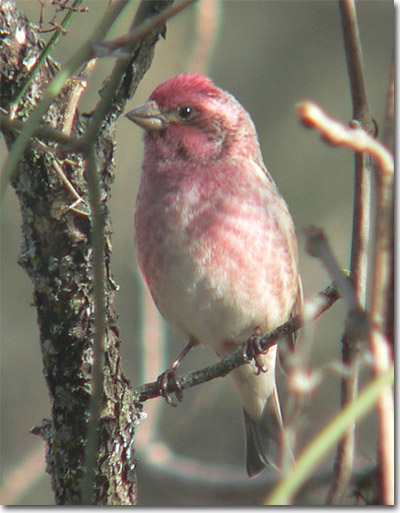by John Shackford

In its online write-up about the Purple Finch (Carpodacus purpureus), Cornell University states: “The Purple Finch is the bird that Roger Tory Peterson famously described as a ‘sparrow dipped in raspberry juice.’” To me there is always something very satisfying about seeing Purple Finches, and Peterson’s phrase catches much that is appealing about this beautiful bird. To clarify, it is the male Purple Finch that has the beautiful raspberry juice—or wine—color that goes over the head and “drips” downward over much of its body. This raspberry color is different from the red of the similar male House Finch—and this difference in color is rather easily distinguished if you get an adequate look with binoculars. The male Purple Finch is most similar in color to the Cassin’s Finch, but Purple Finch males have a more uniform raspberry wash than the Cassin’s Finch. Also, the Cassin’s Finch does not normally range into central Oklahoma (travel to the Black Mesa area in wintertime to have the best chance to see a Cassin’s Finch).
The female Purple Finch also has its own “character”—a strong white stripe behind the eye that (boldly) says “female Purple Finch,” rather than the nondescript face pattern of the female House Finch. Both the male and female Purple Finch have strong brownish-black and white streaking on the body; immature males and older females have a faint wash of “raspberry,” but not nearly so much color as an adult male. Often helpful too is that both a male and a female Purple Finch are seen together, at least in my experience.
The Purple Finch nests over much of southern Canada and into the northern U.S., and it is the state bird of New Hampshire. It lays from 3-6 eggs, usually 4 or 5, and most often nests in coniferous trees, the nest usually being about 15-20 feet high.
In Oklahoma City we are on the western edge of the winter range of the Purple Finch; it shows up here erratically and most years we see very few or none. Then we have a year when they are decidedly more common, although seldom would you say abundant. This past winter has been a “boom” year; we have seen at least 9 at our yard feeders, a considerable jump over the usual zero. Many other people are also reporting them across Oklahoma this winter/spring (2009-10). Because of this influx, humor me for a moment while I suggest that—for this particular winter—we informally adopt the Purple Finch as the State Wintering Bird of Oklahoma! Most of these finches leave some time during April, according to Woods and Schnell (Distribution of Oklahoma Birds, 1984), so watch your feeders for an ending date.
The Latin name of the Purple Finch—Carpodacus purpureus—means purple (purpureus) fruit biter (Carpodacus). On the breeding ground its diet is reported in Bent (1968, Life Histories of North American Cardinals, Grosbeaks, Buntings, Towhees, Finches, Sparrows, and Allies, part 1) to include strawberries, raspberries, blackberries and cherries, both tame and wild; other things it is reported to eat at some time of year include fruit tree blossoms and insects. In winter, its diet is reported to be mainly seeds, and like a lot of small birds, they seem to particularly enjoy black sunflower seeds. In late winter and spring it will also eat the buds of a number of tree species. I suspect the developing pollen and young seeds in these buds provide a lot of nutrition for comparatively little effort for his small finch that weighs only ¾-1 ounce (a 1-ounce letter is about 4 sheets of paper and an envelope—not very much weight).
